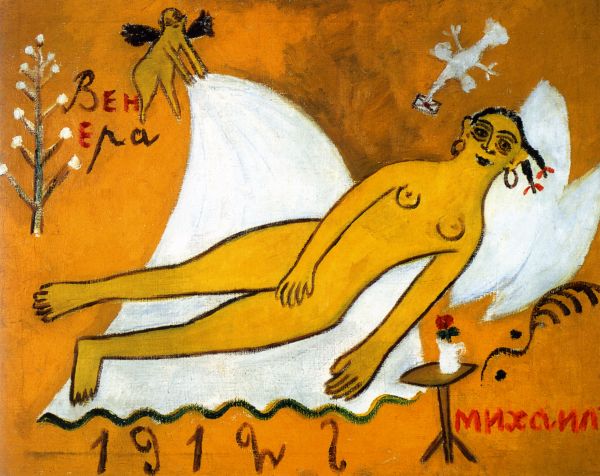|
|
Venus. 1912

Larionov Mikhail,
Oil on Canvas
68 x 85,5
Пост. в 1926 из МХК через ГИНХУК
Annotation
Mikhail Larionov painted Venus in 1912, when he was working in parallel on lithographic books, applying deliberately archaic, “homemade” stylistic devices and addressing the expressive possibilities of handwriting. Like his paintings of this period — the unfinished Venus series and the Seasons cycle — the artist creates something akin to an “instantaneous stroke of the pen”. Larionov was interested in such diverse manifestations of folk creativity as the art of ancient cultures, children’s drawings and graffiti.
Rebelling against “Greco-Roman sanctimoniousness”, he painted his very own series of Venuses. While this particular Venus lies in a classical pose, the element of amour introduces a note of parody. Other associations, however, link the work to primeval images. The painting represents a simplified and generalized drawing; it is virtually a symbol.
Author's Biography
Larionov Mikhail
Larionov, Mikhail Fyorovich (1881, Tiraspole - 1964, Fontenay-aux-Roses (France))
Painter, graphic artist, leader of the Russian avant-garde movement. Studied under Isaac Levitan, Valentin Serov and Konstantin Korovin at the Moscow School of Painting, Sculpture and Architecture (1898-1910). Contributed to exhibitions (from 1898). Contributed to the exhibitions of the Union of Russian Artists (1906-1910), World of Art (1906, 1911-1913, 1915), Stephanos (1907-1908), Wreath (1908), Link (1908), Exhibition of Modern Trends in Art (1908), Golden Fleece Salons (1909-1910), Wreath/ Stephanos (1909), Vladimir Izdebsky Salon (1909-1910), Jack of Diamonds (1910), Union of Youth (1910-1912), Donkey's Tail (1912), Der Blaue Reiter (1912), Der Erste Deutsche Herbstsalon (1913), Target (1913), No. 4. Futurists, Rayonists, Primitive (1914), 1915 (1915), International Exhibitions in Venice (1907, 1920) and the Exhibitions of Russian Art in Paris (1906, 1921) and Berlin (1906). Designed for Sergei Diaghilev's Ballets Russes (1914-1929).

